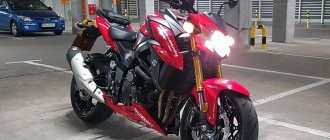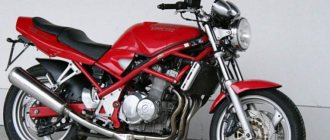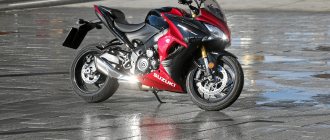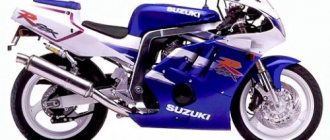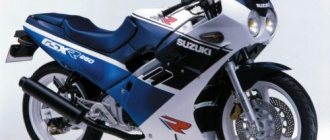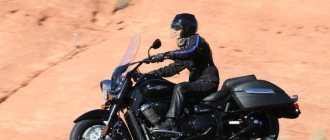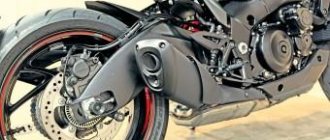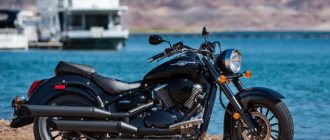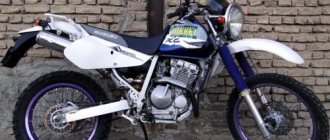| Suzuki GSR750 (GSX-S750) 2011-2016 | Suzuki GSR750S (GSX-S750) 2011-2016 | Suzuki GSX-S750 (2017+) |
Suzuki GSR 750 naked model
was first presented in 2010 at the Intermot exhibition, and went into production at the beginning of 2011. The Suzuki GSR 750 replaced the Suzuki GSR 600, which, although it gained some popularity in the world, did not become a full-fledged flagship in the naked class. In addition, from the experience of competitors, it was clear that buyers were increasingly giving preference to 750 cc models, where Kawasaki with the naked Z750 and Yamaha with the new FZ8 model occupied the lion's share of the market.
Suzuki GSR 750 in the North American market was sold under the name - Suzuki GSX-S750
.
The Suzuki GSR 750 was based on the engine from the 2005 Suzuki GSX-R750 sports model, which was significantly redesigned to suppress the “top end” and increase traction at low and medium speeds. As a result, the engine began to produce 106 hp. power and 80 Nm of torque - a standard indicator for motorcycles of this class and cubic capacity. Maximum motor performance is achieved at 9000-10000 rpm.
Unlike the “little brother” GSR 600, the new Suzuki GSR 750 has a more aggressive appearance, a combined steel frame combining sections from round and D-shaped sections, an inverted KYB fork, a new exhaust system and increased to 17.5 l fuel tank.
In 2012, the Suzuki GSR750 model received versions with ABS, which became mandatory in the European market.
2016 was the last year of production of the model, after which it rolled off the production line, offering the market a new generation of GSR750 under the name Suzuki GSX-S750.
Suzuki GSR750 modifications:
- Suzuki GSR750
is the regular version. - Suzuki GSR750S
- version with body kit (windshield, radiator protection, carbon body elements).
The main competitors of the Suzuki GSR750 in the class:
- Kawasaki Z750 / Kawasaki Z800
- Yamaha FZ8
- Honda CB600F Hornet (2007-2012)
Brief history of the model
- 2011 - start of production and sales of the Suzuki GSR750 model.
Model
: Suzuki GSR750 (Europe, Australia, Japan);
Suzuki GSX-S750 (North America). Factory designation
: GSR750L1.
- 2012 - the appearance of modifications with ABS (included as standard equipment in the European market).
Model
: Suzuki GSR750 +ABS (Europe, Australia, Japan);
Suzuki GSX-S750 +ABS (North America). Factory designation
: GSR750L2; GSR750AL2.
- 2013 - no significant changes.
Model
: Suzuki GSR750 +ABS (Europe, Australia, Japan);
Suzuki GSX-S750 +ABS (North America). Factory designation
: GSR750L3; GSR750AL3.
- 2014 - no significant changes.
Model
: Suzuki GSR750 +ABS (Europe, Australia, Japan);
Suzuki GSX-S750 +ABS (North America). Factory designation
: GSR750L4; GSR750AL4.
- 2015 - no significant changes.
Model
: Suzuki GSR750 +ABS (Europe, Australia, Japan);
Suzuki GSX-S750 +ABS (North America). Factory designation
: GSR750L5; GSR750AL5.
- 2016 is the last year of production.
Model
: Suzuki GSR750 +ABS (Europe, Australia, Japan);
Suzuki GSX-S750 +ABS (North America). Factory designation
: GSR750L6; GSR750AL6.
Development Basis
Therefore, the development of the new bike rolled on different rails - from smaller (GSR 600) to larger . Released in 2011, the motorcycle did not sell very well, so it lasted on the assembly line for only 5 years, and was discontinued 2016 No changes were made to the design.
Almost immediately it was clear that the “child” was not a survivor, and applying some innovative solutions to try to resuscitate him was considered a futile undertaking. Only to comply with European standards, ABS began to be installed in 2012.
Specifications
Technical characteristics of Suzuki GSR 750:
| Model | Suzuki GSR750 (GSX-S750) |
| Motorcycle type | naked |
| Year of issue | 2011-2016 |
| Frame | steel |
| engine's type | 4-cylinder, 4-stroke, in-line |
| Working volume | 749 cm³ |
| Bore/Stroke | 72.0 x 46.0 mm |
| Compression ratio | 12,3:1 |
| Cooling | liquid |
| Number of valves per cylinder | DOHC, 4 valves per cylinder |
| Fuel supply system | injector with SDTV (Suzuki Dual Throttle Valve), 4x |
| Ignition type | fully transistorized |
| Maximum power | 106.0 hp (78.0 kW) at 10000 rpm |
| Maximum torque | 80.0 Nm (8.1 kg*m) at 9000 rpm |
| Clutch | Multi-disc in oil bath, cable drive |
| Transmission | 6-speed |
| type of drive | chain |
| Front tire size | 120/70ZR17 M/C (58W) |
| Rear tire size | 180/55ZR17 M/C (73W) |
| Front brakes | 2 discs 310 mm, 2-piston calipers (GSR750A - ABS) |
| Rear brakes | 1 disc 240 mm, 1 piston caliper (GSR750A - ABS) |
| Front suspension | 41mm inverted fork (preload adjustable), 120mm travel |
| Rear suspension | pendulum with monoshock absorber (7-step preload adjustment), stroke - 135 mm |
| Length | 2115 mm |
| Width | 785 mm |
| Height | 1060 mm |
| Wheelbase | 1450 mm |
| Minimum ground clearance (clearance) | 145 mm |
| Seat height | 815 mm |
| Acceleration 0-100 km/h (0-60 mph) | 3.32 sec[1] |
| Maximum speed | 255 km/h[2] |
| Gas tank capacity | 17.5 l |
| Motorcycle weight (curb) | 210 kg – GSR750 213 kg – GSR750A (ABS) |
Modifications
The bike does not have its own modifications, but the user was offered a choice of configurations.
Suzuki GSR 750.
Suzuki GSR 750 S.
Suzuki GSR 750 is a basic naked bike.
Suzuki GSR 750 S - basic naked + additional body kit:
- radiator protection;
- carbon in design;
- windshield, etc.
and competitors
The situation with competitors was as follows. In addition to the above-mentioned FZ8 from Yamaxa, Honda presented its legendary Hornet - the third generation CB600F, and Kawasaki gave birth to two models at once - the Z750 and Z800. The second successor to the first.
Reviews
Reviews about Suzuki GSR750:
Expand Collapse
The Suzuki GSR750 does not amaze or shock - it is a very ordinary city motorcycle, a mass product designed for a pragmatic European consumer with a sense of taste. But it is also a multifaceted prism, the color of which changes depending on the angle from which you look at it. On the one hand, there is an excellent engine, the settings of which will suit both a beginner and a rider with pretensions, a successful design, and easy and “transparent” handling. On the other hand, there are terrible brakes, some deliberately cheap parts and components, and the actual “single-seater” of the motorcycle.
I didn’t like the new GSR 750 at all))) the chassis, in addition to the fork, is a full budget, the swingarm is finally tinny, like on a sabotage Yamaha), and the frame is flimsy) the brakes are terrible, considering that on the GSR 600 (they are from Jixer there) they are not 5k), The new one definitely doesn’t handle as well as the 600ka, but on the track it’s exactly the same. There’s probably a crisis - but be that as it may, it’s not worth saving on the frame and swingarm) +sy - a beautiful shell and the engine is probably normal, but I definitely wouldn’t take one like that) by the way, last season I had a chance to ride an FZ8, mixed feelings - the steering wheel is painfully wide , the footpegs are lower than those of the GSR and are located closer to the front, in short the landing is less sporty, or rather quite classic), the feeling is more “sofa”, but on long trips you will probably get less tired than on the GSR, in corners it’s okay, but the engine seemed to me even weaker than on the 600m GSR, smoother, although it seems to be torquey, I thought it was because of a defect, the GSR has 3 parts in stock and there is a bad one, then I sat back on my GSR with the suspensions tightened almost all the way, the GSR on his background seemed sharp and hard...
Features of Suzuki GSR 750
The motorcycle looks much lighter in appearance than it actually weighs.
Among the features of the bike were noted:
- injector + SDTV;
- sports-type motor, tuned for beginners;
- upside-down fork;
- bad brakes;
As some users noted, it is better to admire the motorcycle from afar - so as not to see its budget and savings on all the details.
Suzuki GSX-S750 test
It has been our long-time dream to experience it. Technically, this review is a year out of date - because we got the 2021 model, but for 2021 it received absolutely no changes, so just mentally replace the last zero with one. Our example comes in Metallic Triton Blue, Suzuki's official racing color, which shines beautifully in the bright sun, but is also available in Matt Black.
It’s no wonder that 750 cc models have a lot of admirers, both classic old-school and ultra-modern: they are lighter than liter ones and, with the right priorities, are just as responsive and nimble, or just as fast. And sometimes at the same time, with skillful work with the left foot. I am one of the fans of this cubic capacity, but I am also familiar with other GSX-S and GSX-R: I had a GSX-S1000, I had a GSR750. I attended the launch of the GSX-S1000 in 2015, rode several GSX-R750s and 1000s from different years, and probably touched a dozen old 750s (and even dreamed of starting a collection at one time).
In short, on the road and on the track I prefer the 750 engines over the 1000, and I’m ready to explain why. I like it when a bike (or its engine) demands the right approach from me. It pulls well at the bottom (though not like the 1000), picks up well, and the gears on it are optimally selected, all that remains is to click them at the right time. It is nimble, has a pleasant intake growl and an angry exhaust roar. I’m now talking about several 750 models at once - the old GSR750, the GSX-R750 K5 series, and the modern GSX-S750 (in the updated Euro 4 version it is a little more powerful, more economical and equipped with a new exhaust). same engine.
Suzuki GSX-S750
At idle, the Suzuki GSX-S750 sounds just great, daring and daring. It takes corners brilliantly, is comfortable in the city, copes well in any traffic and easily drives away from it. In real conditions, more is simply not required, that is, for an everyday road naked bike, the 750 is more than enough.
It has quite good traction at medium speeds, pleasant smooth throttle, excellent throttle response, and in the city it is fun and obedient at the same time. But when you let go of the reins and squeeze out all its 115 horses, then it really captivates! The inline-four revs very high, makes peak power at 10,500 rpm and revs even further, allowing for fewer shifts when you don't need to push it all the way.
The Suzuki GSX-S750 transmission is clear and distinct, its gears are close together, and the only thing missing is a quickshifter. That, and, perhaps, a tuning exhaust - that’s all I would buy for myself if I had the chance to own this motorcycle.
The intake whine sounds old-school, and for good reason - Suzuki has been using this engine since 1985. It has since gone through several revisions, but in its current form it has existed since 2005.
The Suzuki GSX-S750 feels much lighter than its 213kg, it's nimble, shifts much easier than the GSX-S1000 or Katana, and handles just fine. Its geometry gives the highest level of control and clear feedback. Whether you're braking into a corner on the GSX-S750 or flying into a corner without stopping (which is easy with a slipper clutch), the chassis provides complete control and confidence without feeling like a wild, unbridled and uncontrollable beast that is trying to kill its rider. You can really drive the S750 for all your money, if you have the skill, of course.
Suzuki GSX-S750
The 750 is equipped with sportier suspensions than the 1000. They are collected and even tough, and, no wonder, very simple. But what’s surprising is that with almost 100 kg in my equipment, they work as if they were created and tuned just for me. On a good road with sharp turns, powerful trail breaking and exiting corners on powerful gas, they perform just as well as on poor quality asphalt in small villages. It’s scary to think how many people crowd into the courtyard of a house located exactly at the corner of a 90-degree turn on a fairly busy highway - you need nerves of steel to live there. But to my great joy, this turn of the S750 went like a glove.
In general, the Suzuki GSX-S750 is an excellent universal motorcycle: good asphalt suspension, smooth engine running, and does not dry out your hands with vibration or recoil. Despite its modest size, the fit is quite comfortable (albeit a bit wide in the tank), the steering wheel is low, rather narrow, with a comfortable bend and does not require much effort. In general, the ergonomics are, so to speak, old-school: a simple LCD instrument panel, and yet it has everything you need.
Traction control and so on are controlled as standard for Suzuki from the left remote control, simply and tastefully, just the way I like it. The levers are customizable, the remote controls, etc. are located completely standard, the electronics work predictably and clearly. I mostly drove with the traction control set to two, and the ABS on the Nissin brakes handled the emergency braking test quite well. This is a simple and relatively inexpensive motorcycle that has everything you need to get the essence of riding without too much frills.
Suzuki GSX-S750
At the same time, the Nissin brakes themselves are beyond praise: four-piston radial calipers on 310 semi-floating discs at the front. They have excellent initial grip and responsive modulation with excellent stopping power reserves. The rear brake is just enough for cornering and stability. Even if I wanted to, I cannot find fault with the brakes on this motorcycle - even the position of the lever and its shape are optimal and natural.
During normal road driving, there are practically no vibrations, unless, of course, you rev the forced 750 cc engine to the cut-off point. In normal modes it operates softly and smoothly, allowing you to ride hour after hour without fatigue. The seat is comfortable, quite soft but still supportive for sporty, overhanging riding.
The footpegs are positioned optimally: with my 187cm and long legs, it’s a little cramped for me, but I’m not willing to sacrifice an inch of ground clearance in order to sit more freely, and the collected position pleasantly improves handling in corners. The dashboard of the Suzuki GSX-S750 is located somewhat poorly (or simply too small), you have to look closely, the mirrors do not vibrate, but are too small, the side stand did not cause any difficulties. I didn’t ride with a passenger, but the passenger seat itself is very simple - instead of handles, the second person is asked to hold on to the strap or (as we like) to the driver.
The steering wheel turns quite far, which is convenient in the city. Other advantages for city use include an immobilizer and steering wheel lock, as well as a small glove compartment under the seat where you can carry a chain or disc lock. Another nice touch is the automatic speed control, which applies gas when the clutch is released, and the Easy Start function, which allows you to start the engine by simply pressing the starter button and without holding it down. For country trips, there is a 16-liter tank, which gives a good power reserve (consumption is 5 liters per hundred), a conventional fairing on the headlight and small aerodynamic side plastic of pleasant quality. The parts are well fitted, everything looks very nice - black frame, swingarm, wheels, handlebars, yokes, engine, muffler (a completely black exhaust is standard on the motorcycle in the Matt Black scheme, and in blue it has a silver finish) and so on and so forth. laconic blue body kit. The fasteners are traditionally of high quality, and overall the motorcycle gives a very pleasant impression of a good Japanese thing.
The Suzuki GSX-S750 is a really good thing - as an everyday motorcycle, which on weekends is not a shame to ride either on a country road or on a track. It's well thought out and well made, has tons of parts and aftermarket options, and can be outfitted to your heart's content. Or leave it stock!
